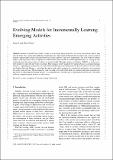Evolving models for incrementally learning emerging activities
Abstract
Ambient Assisted Living (AAL) systems are increasingly being deployed in real-world environments and for longperiods of time. This significantly challenges current approaches that require substantial setup investment and cannot account forfrequent, unpredictable changes in human behaviours, health conditions, and sensor deployments. The state-of-the-art method-ology in studying human activity recognition is cultivated from short-term lab or testbed experimentation, i.e., relying on well-annotated sensor data and assuming no change in activity models. This paper propose a technique,EMILEA, to evolve an ac-tivity model over time with new types of activities. This technique novelly integrates two recent advances in continual learning:Net2Net – expanding the architecture of a model while transferring the knowledge from the previous model to the new modeland Gradient Episodic Memory – controlling the update on the model parameters to maintain the performance on recognisingpreviously learnt activities. This technique has been evaluated on two real-world, third-party, datasets and demonstrated promising results on enhancing the learning capacity to accommodate new activities that are incrementally introduced to the modelwhile not compromising the accuracy on old activities.
Citation
Ye , J & Callus , E 2020 , ' Evolving models for incrementally learning emerging activities ' , Journal of Ambient Intelligence and Smart Environments , vol. 12 , no. 4 , pp. 313-325 . https://doi.org/10.3233/AIS-200566
Publication
Journal of Ambient Intelligence and Smart Environments
Status
Peer reviewed
ISSN
1876-1364Type
Journal article
Collections
Items in the St Andrews Research Repository are protected by copyright, with all rights reserved, unless otherwise indicated.

